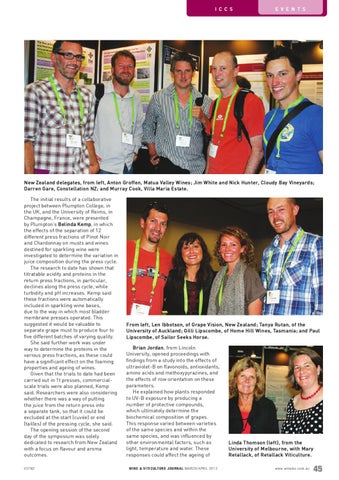I C C S
E V ENTS
New Zealand delegates, from left, Anton Groffen, Matua Valley Wines; Jim White and Nick Hunter, Cloudy Bay Vineyards; Darren Gare, Constellation NZ; and Murray Cook, Villa Maria Estate. The initial results of a collaborative project between Plumpton College, in the UK, and the University of Reims, in Champagne, France, were presented by Plumpton’s Belinda Kemp, in which the effects of the separation of 12 different press fractions of Pinot Noir and Chardonnay on musts and wines destined for sparkling wine were investigated to determine the variation in juice composition during the press cycle. The research to date has shown that titratable acidity and proteins in the return press fractions, in particular, declines along the press cycle, while turbidity and pH increases. Kemp said these fractions were automatically included in sparkling wine bases, due to the way in which most bladder membrane presses operated. This suggested it would be valuable to separate grape must to produce four to five different batches of varying quality. She said further work was under way to determine the proteins in the various press fractions, as these could have a significant effect on the foaming properties and ageing of wines. Given that the trials to date had been carried out in 1t presses, commercialscale trials were also planned, Kemp said. Researchers were also considering whether there was a way of putting the juice from the return press into a separate tank, so that it could be excluded at the start (cuvÊe) or end (tailles) of the pressing cycle, she said. The opening session of the second day of the symposium was solely dedicated to research from New Zealand with a focus on flavour and aroma outcomes. V2 7N 2
From left, Len Ibbotson, of Grape Vision, New Zealand; Tanya Rutan, of the University of Auckland; Gilli Lipscombe, of Home Hill Wines, Tasmania; and Paul Lipscombe, of Sailor Seeks Horse. Brian Jordan, from Lincoln University, opened proceedings with findings from a study into the effects of ultraviolet-B on flavonoids, antioxidants, amino acids and methoxypyrazines, and the effects of row orientation on these parameters. He explained how plants responded to UV-B exposure by producing a number of protective compounds, which ultimately determine the biochemical composition of grapes. This response varied between varieties of the same species and within the same species, and was influenced by other environmental factors, such as light, temperature and water. These responses could affect the ageing of W i n e & V iticultur e Jo ur n a l MARC H /APRIL 2012
Linda Thomson (left), from the University of Melbourne, with Mary Retallack, of Retallack Viticulture. www.w inebiz. com . au
45
